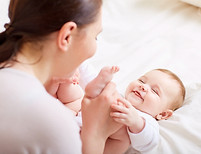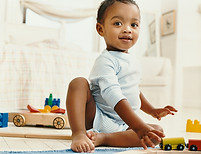












Newborns to 18 Months

Our Infant curriculum starts with regular playtime including tummy time and open-ended exploration, sensory stimulation, outdoor play, as well as nap, diapering routines, and feeding times that are tailored to each infant’s needs. This creates a solid foundation for your little one’s future growth and development.
Every day will be a fun new adventure for your little one, and while our lessons and curriculum prepare them to meet important goals, we want to ensure they are developing at the right pace.
By creating strong bonds, learning through play, and stimulating their five senses, even our youngest students are encouraged to explore in a safe and nurturing environment.
In Our Infant Curriculum We:
Develop Fine Motor Skills to help them begin to acquire motor control that will set them up for success in preschool and beyond.
Infants develop their fine motor skills
by clapping their hands to music, picking up finger foods, and holding onto their favorite toys to build hand and finger dexterity along with hand-eye coordination.


Make sounds and movements that allow them to communicate with caregivers and express their wants and needs and to recognize familiar words when spoken.
From hearing to processing sounds to palate development, language skills flourish by expressing wants and needs, repetition and the use of American Sign Language. This reduces pre-verbal frustration by closing the gap between their desire and ability to communicate while having their needs understood.


Develop physical skills like crawling, rolling, standing and walking, so they can explore their world., even learning to feed themselves.
When babies are crawling, exploring
their environment, and taking their
first steps, they are getting stronger
from head to toe.





During infancy, children develop motor skills, experience tummy time, explore and learn through interaction with their teachers. Our caregivers use this opportunity to work on stretches, leg movements, and ensuring the infants are practicing hand-eye coordination to prepare themselves for the next stages of early childhood development.
As they reach late infancy, our caregivers work with infants to develop those core muscles. They’re learning to crawl, express their emotions, and move their legs and arms. Cognitively, they are learning to identify and recognize family members and caregivers as they come into the room. They’re even learning to produce those first adorable babbling sounds we love to hear.


INFANT PROGRAM

Form and maintain a secure attachment
to parents and caregivers, helping your child to create an internal sense of security
and safety.
Each smile, embrace, and encouraging word builds trust and helps infants thrive in social settings, which sets them up for healthy relationships.


Help them use their senses to
experience and investigate the world
around them.
By stimulating brain function, infants
are invited to become investigators
and cheer on their discoveries,
which builds skills such as object permanence and rationalization.

